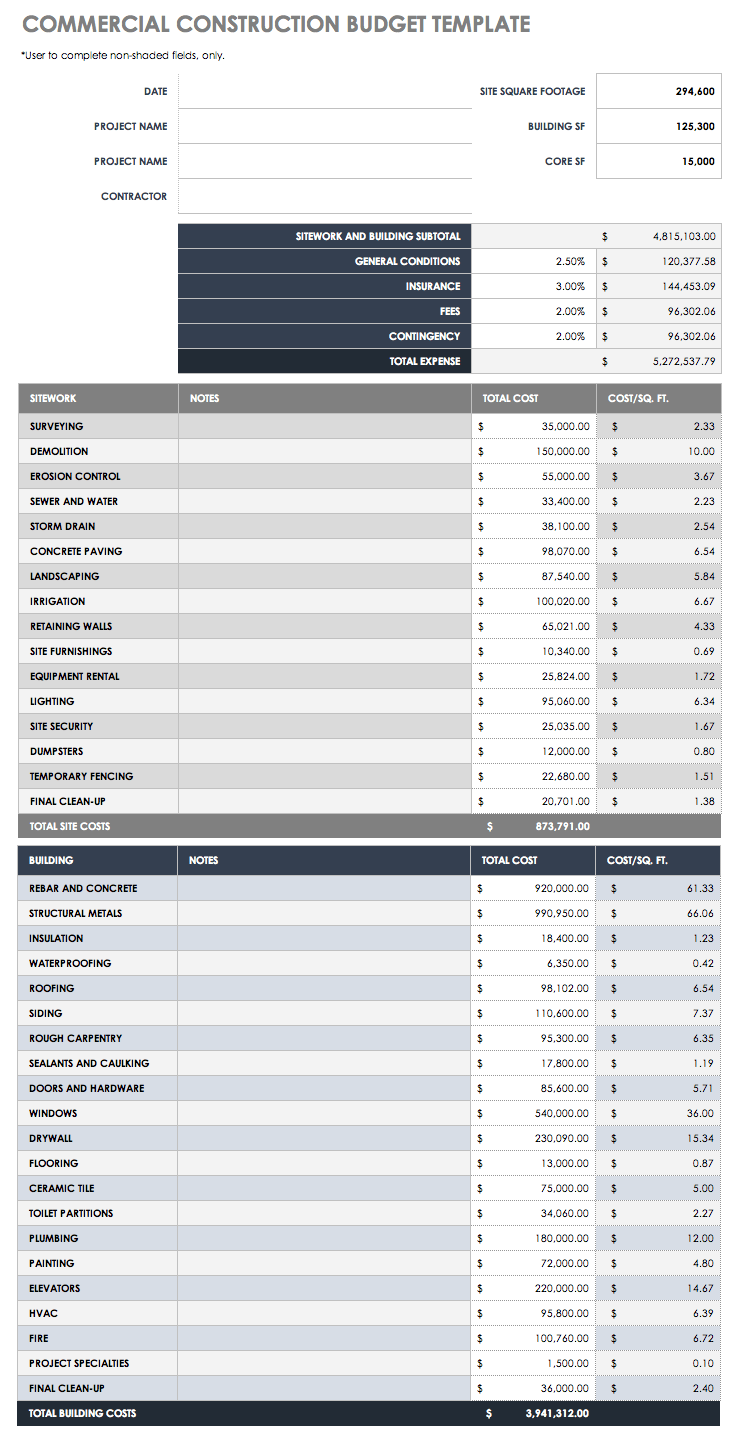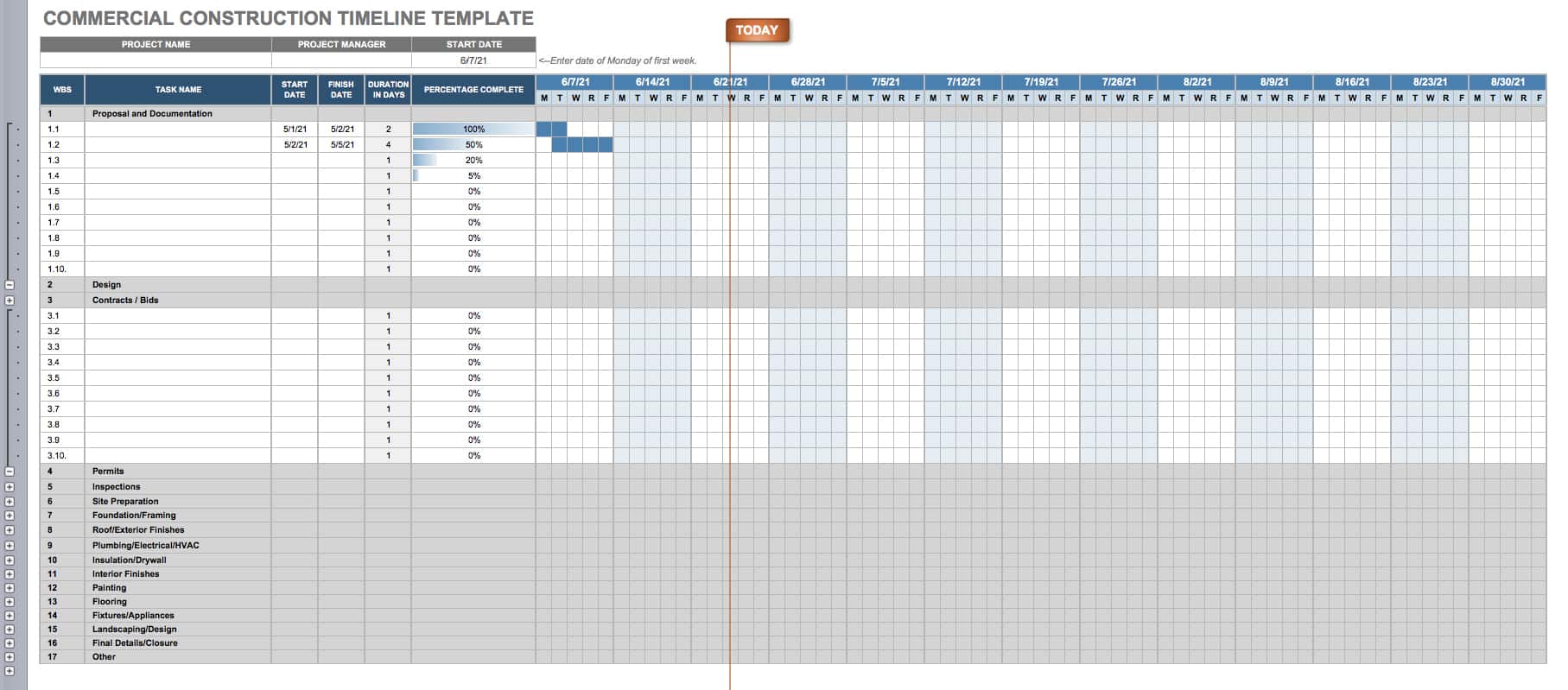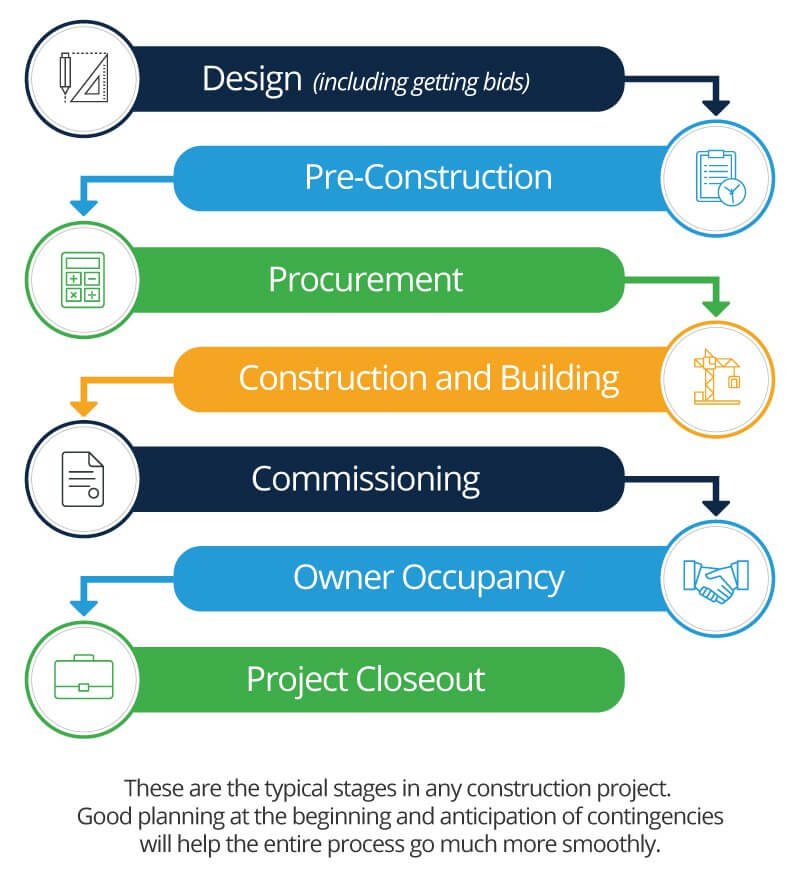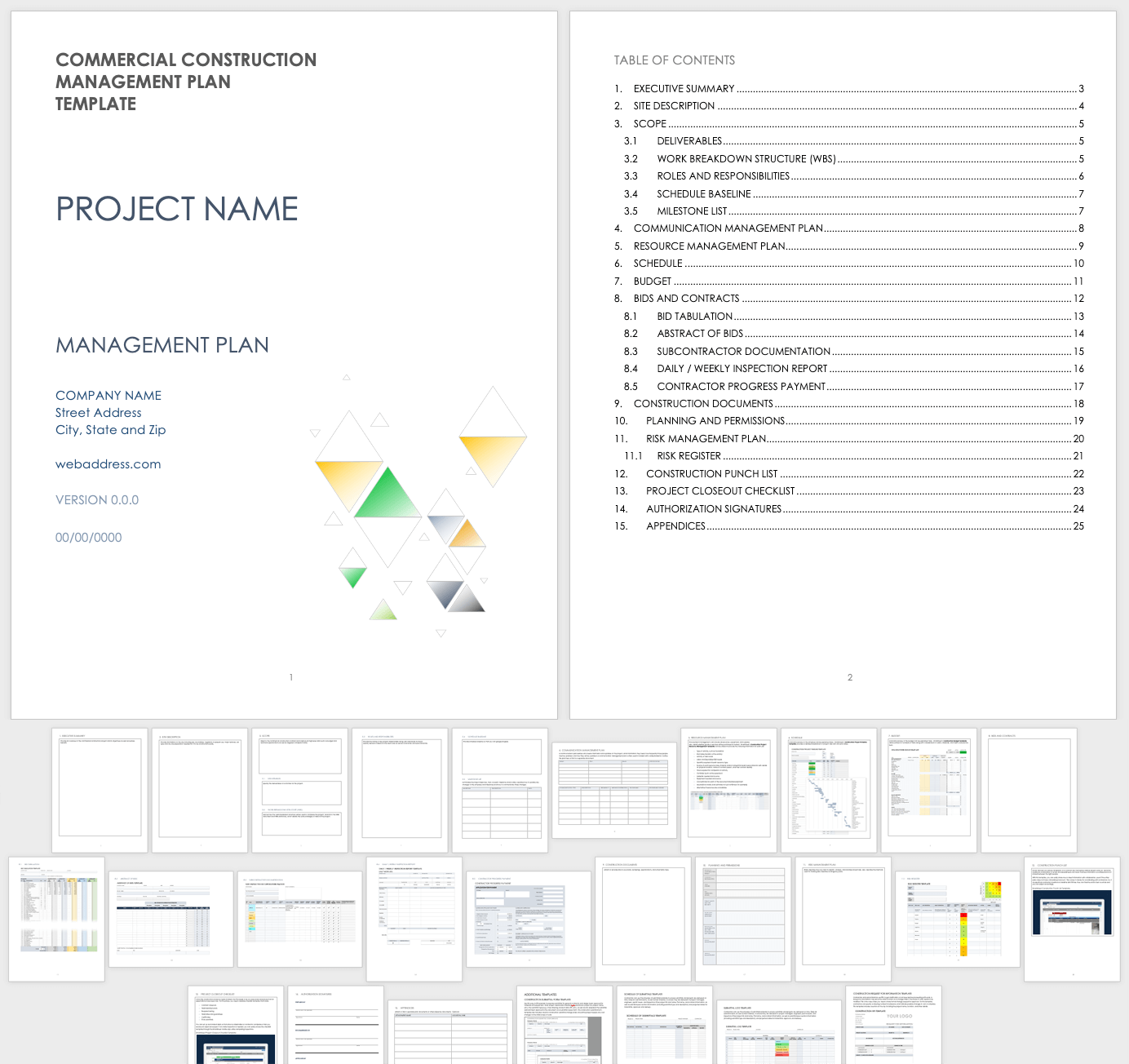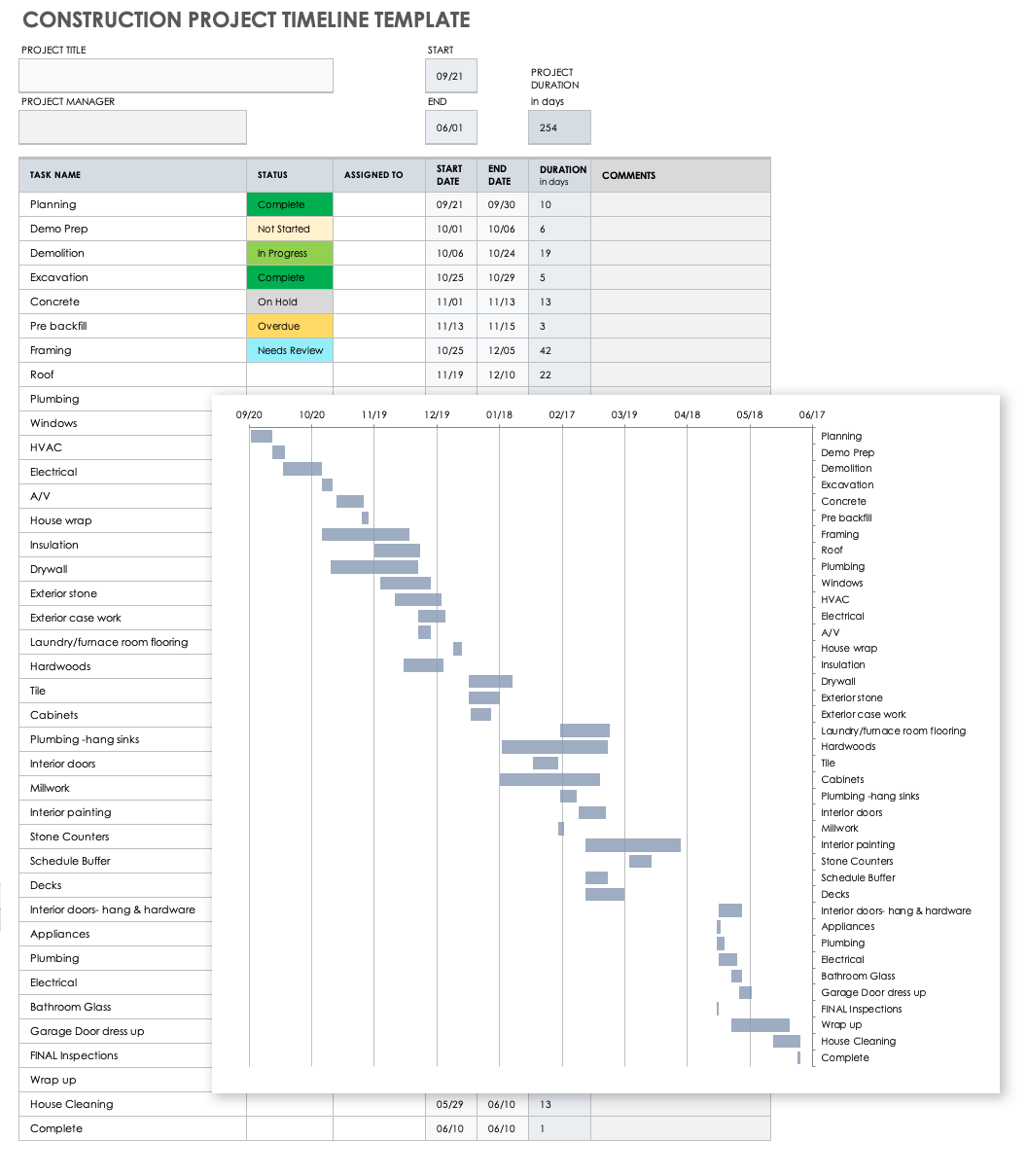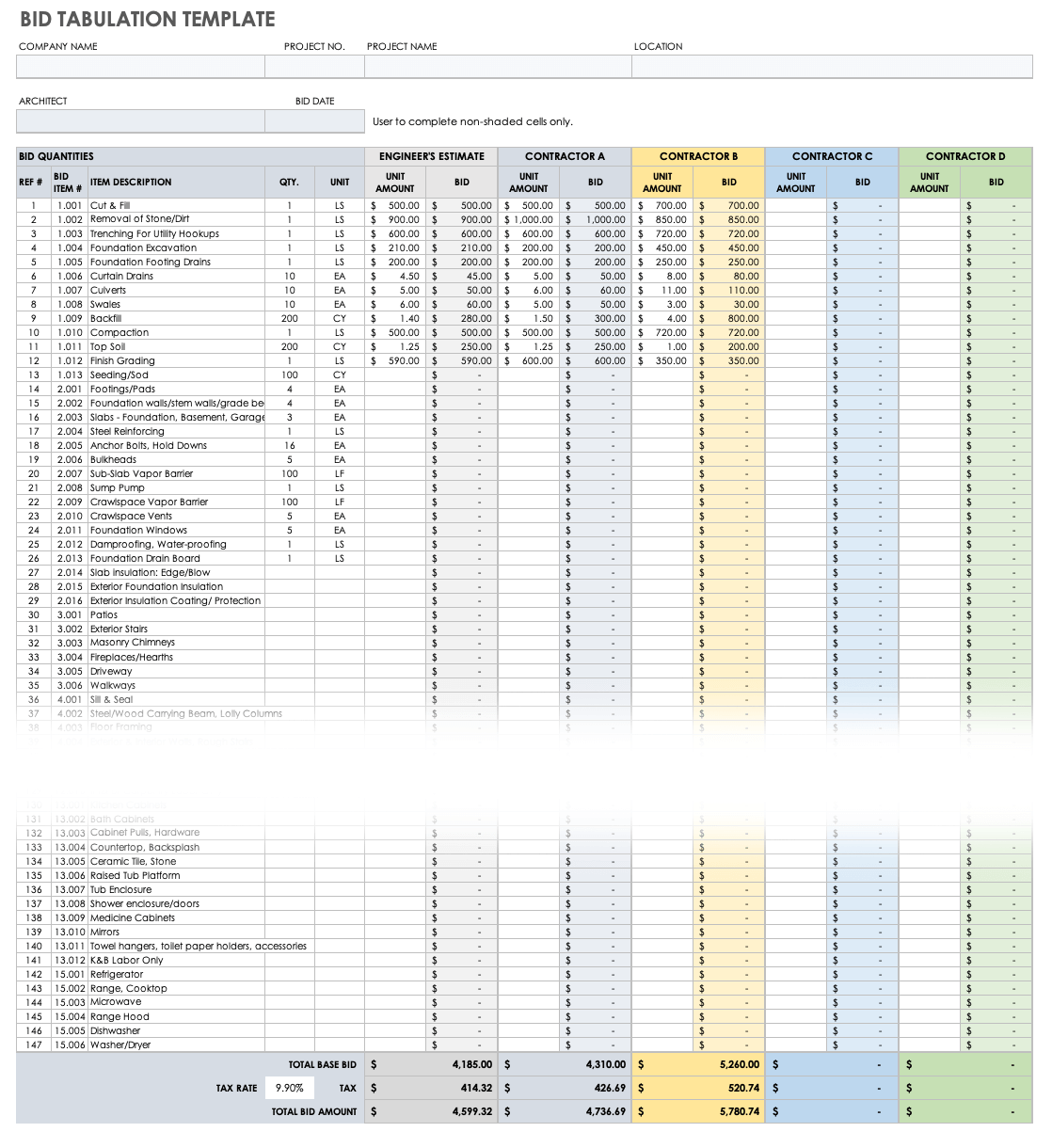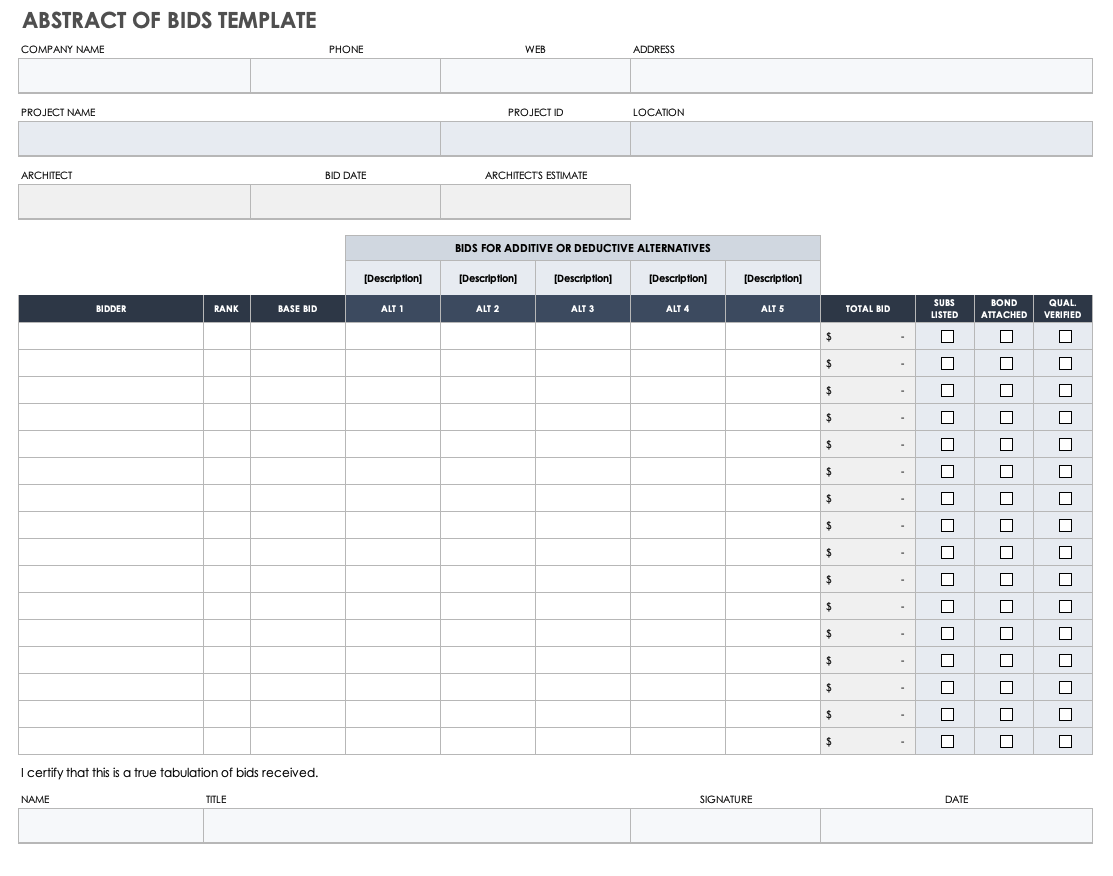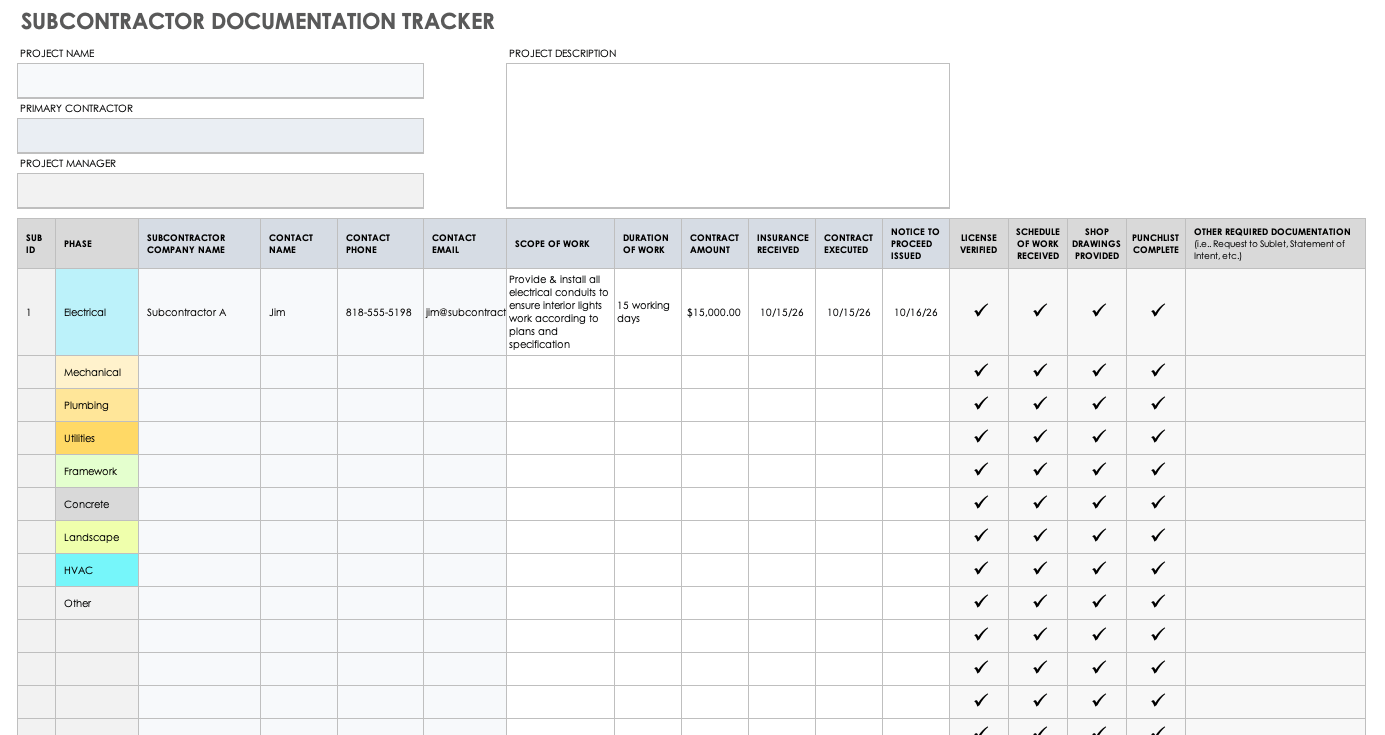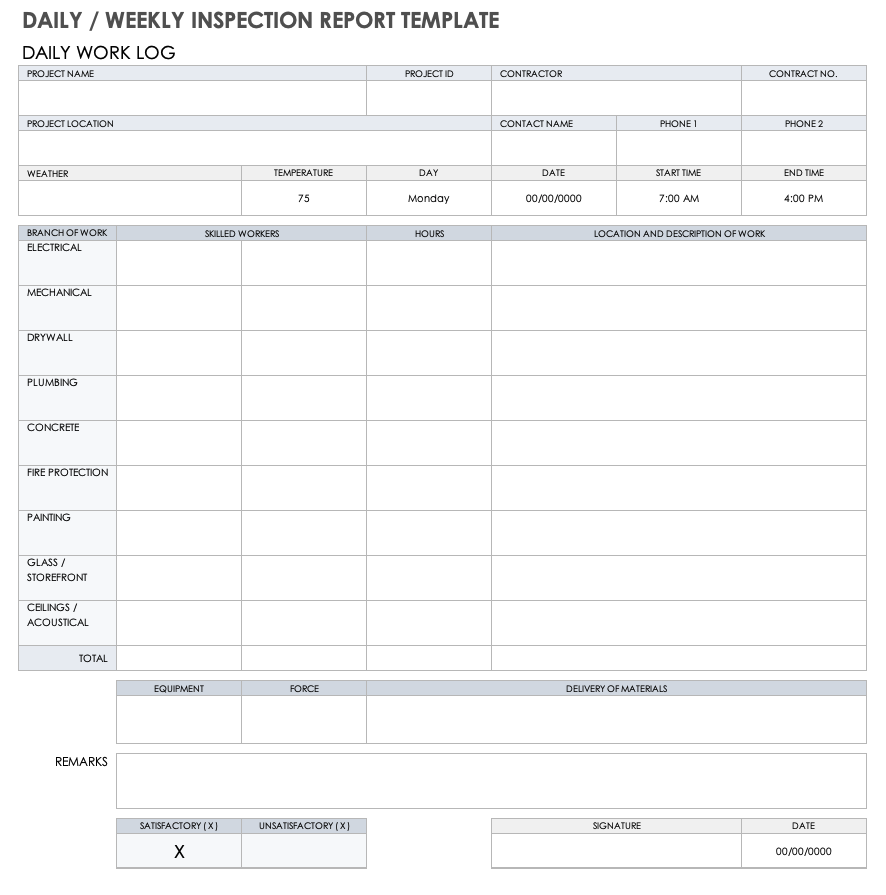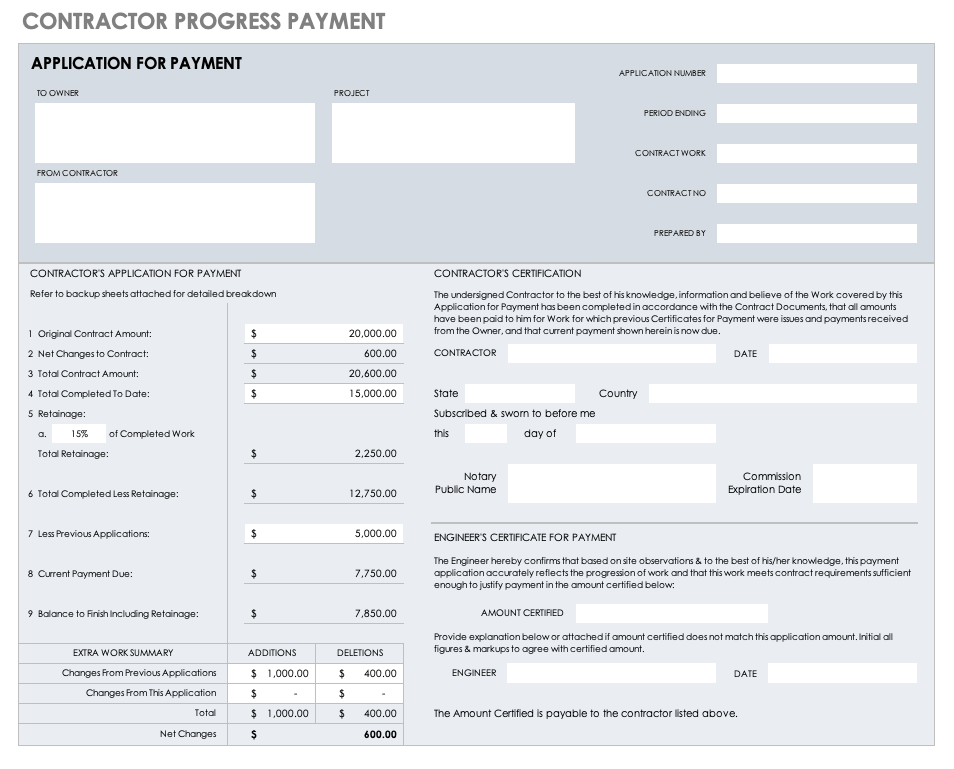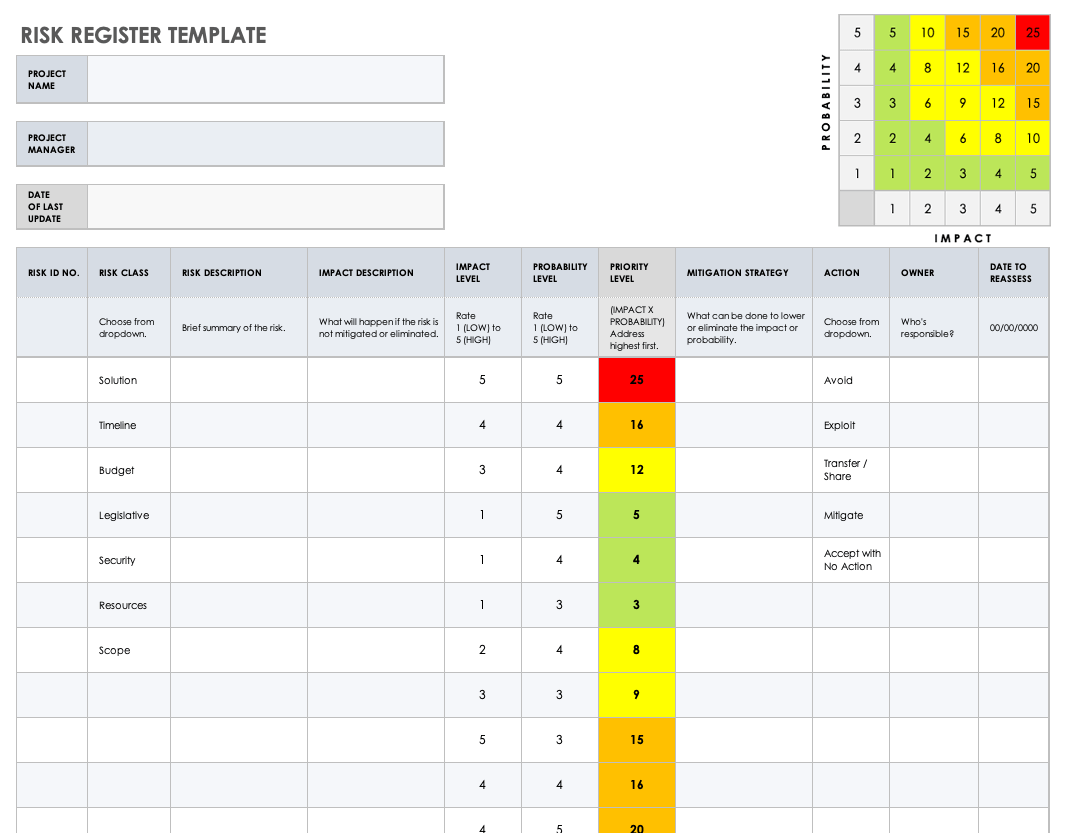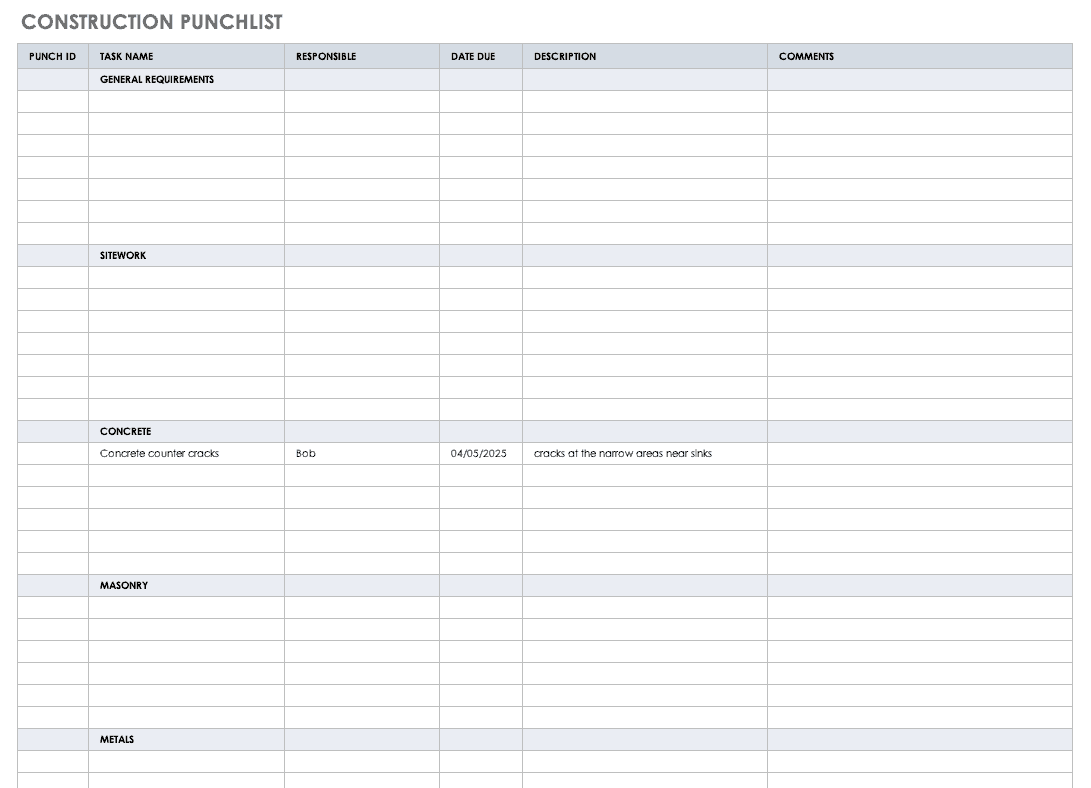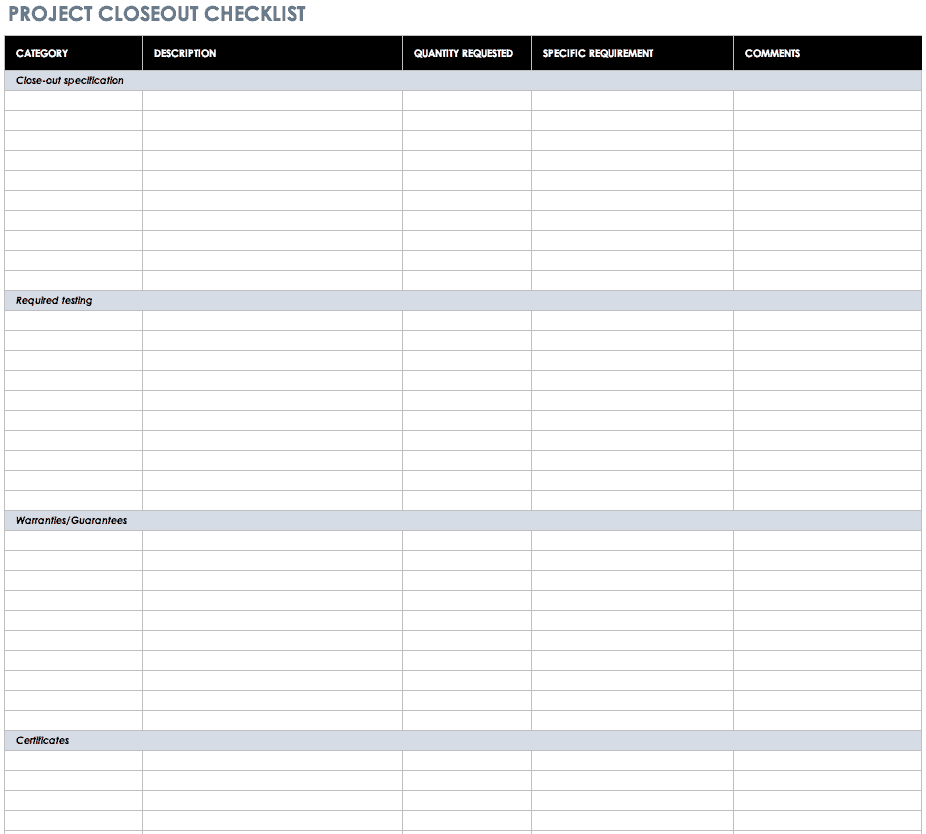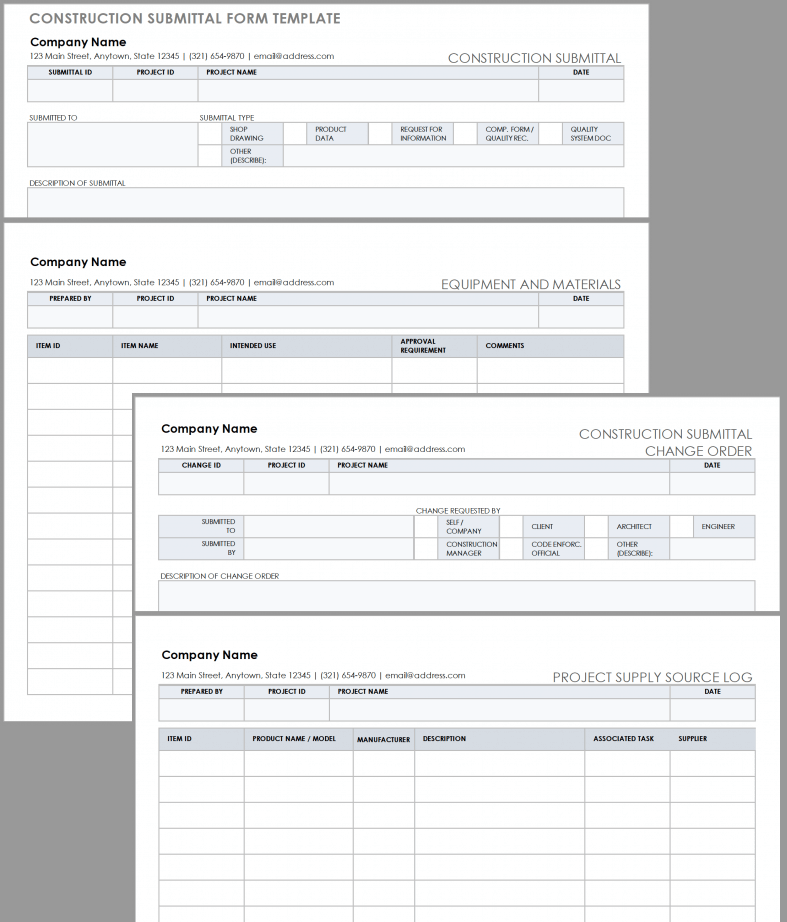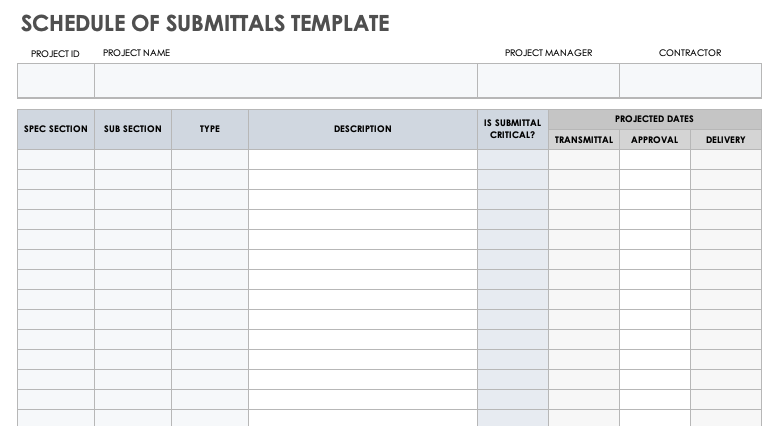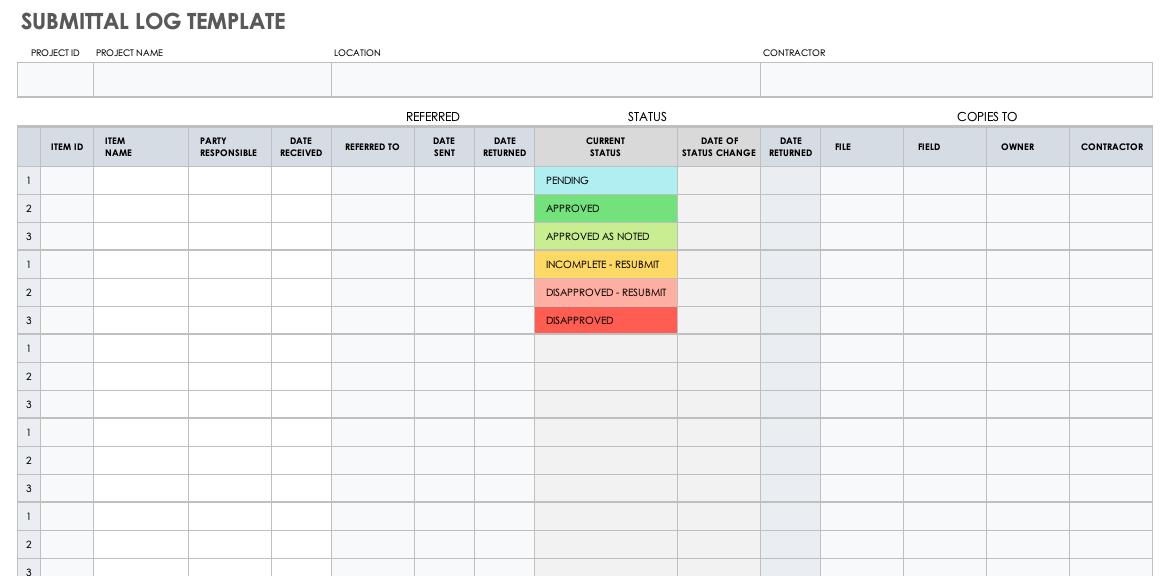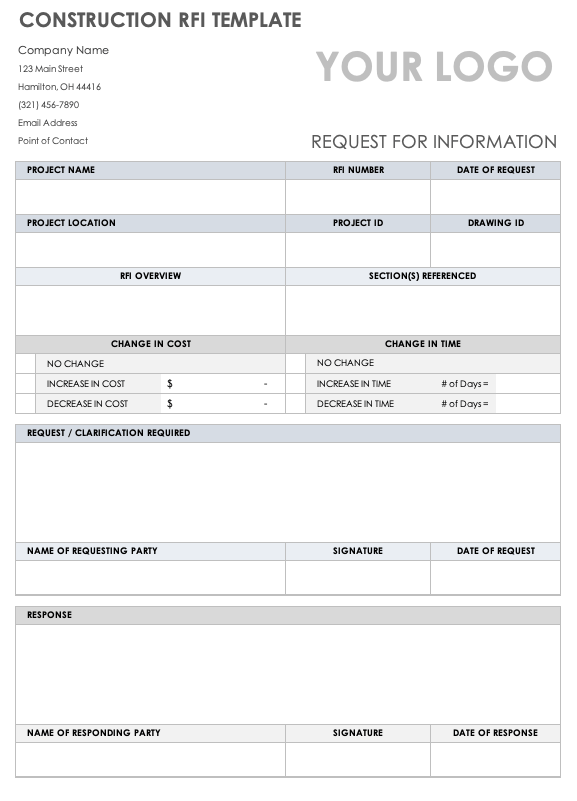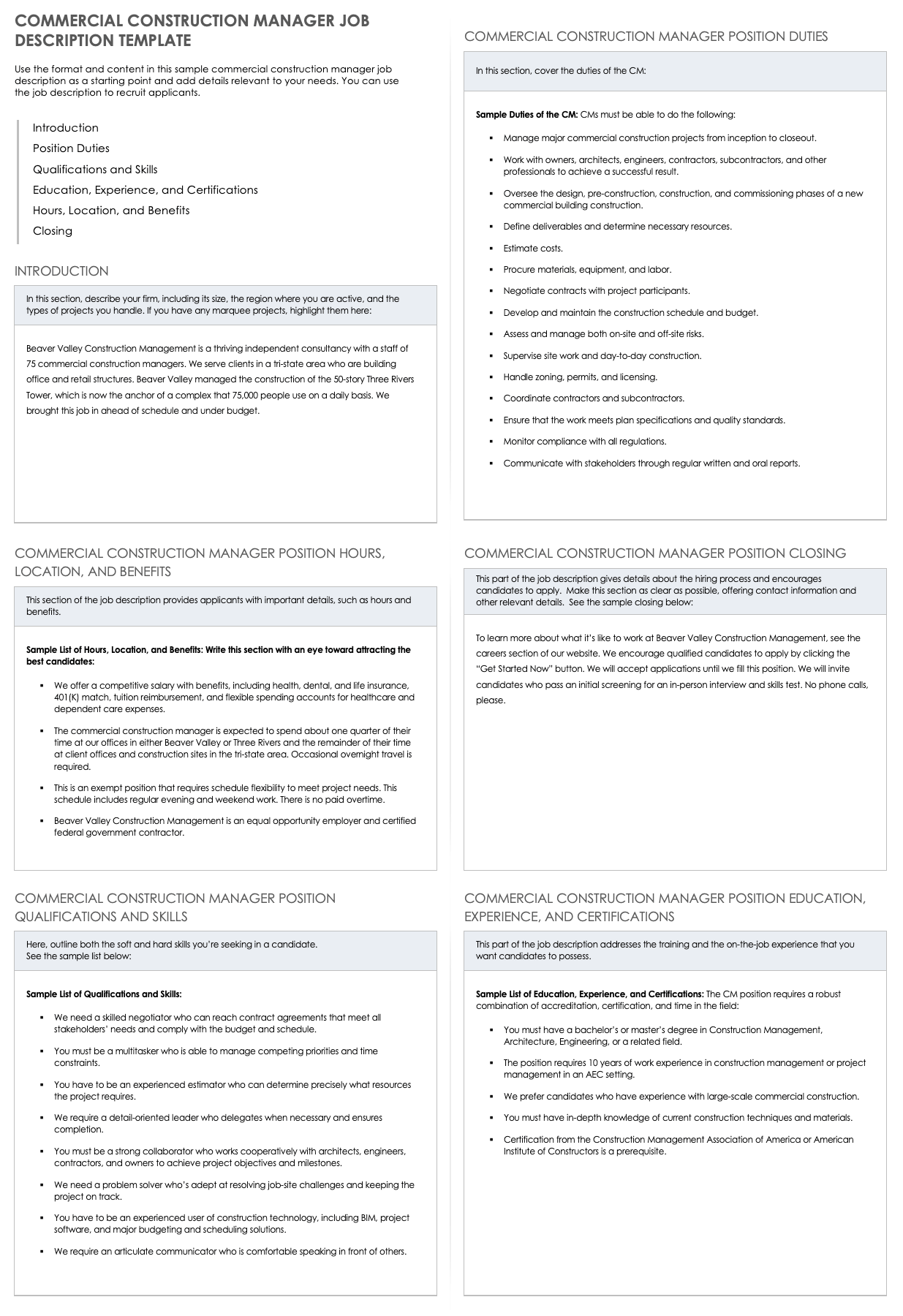What Is Commercial Construction Management?
Commercial construction management (CM), also called commercial construction project management (CPM), uses business principles to make building projects more successful. These techniques address scheduling, cost, scope, quality, function, and safety.
Construction managers improve project efficiency by leveraging their expertise in both construction and project management. Commercial construction managers represent the interests of the owners and oversee the commercial construction process from start to finish. They coordinate architects, engineers, contractors, and subcontractors from pre-design to project completion.
The term commercial construction refers to the building of structures for use by private-sector businesses. This field includes a wide variety of building types, such as factories, office towers, and shopping malls.
However, commercial construction management principles do not apply exclusively to the private sector. Many other large-scale projects also incorporate these principles, such as large residential developments, industrial construction, and public-sector construction, like schools and roads.
The Commercial Construction Management Association of America (CMAA) has led the development of the CM discipline. Its Construction Management Body of Knowledge and Standards of Practice document best practices and ethical standards for the profession.
Depending on the scale of your project, your CM may consist of one individual manager or a whole team.
Residential vs. Commercial Construction Management
Commercial construction differs from residential building in many ways, including size, purpose, materials, regulation, systems complexity, budget, and stakeholders.
Residential construction generally refers to single-family homes and projects of four units or fewer, as well as remodels of these homes. The building of large apartment complexes and subdivisions, with dozens or even hundreds of homes, operates as commercial construction.
The distinctions between residential and commercial building are as follows:
- Size: Commercial buildings are typically much larger than homes. For this reason, it’s more challenging to coordinate a commercial project and adhere to its schedule and budget.
- Purpose: Residential construction creates living spaces. Commercial buildings are those that the owner intends to use to make a profit.
- Materials: Residential buildings are primarily timber framed. Commercial buildings generally require steel and concrete. Homes usually have shingle roofs, while the roofs of commercial structures call for bitumen or thermoplastic polyolefin (TPO). The latter category of materials give builders the ability to construct larger and taller structures, and can also withstand heavier use.
- Regulation: Building codes for commercial structures are more strict. For example, commercial codes require sprinkler systems to put out fires. (Residential codes do not include this requirement.) For commercial projects, governments may dictate construction methods, design, and size, as well as electrical and plumbing specifications. The process for acquiring permits for commercial buildings can take months or even years, and may entail public hearings. Home construction undergoes a simpler review.
- Systems: Commercial building systems are complex because these systems serve larger structures (with more users) and, therefore, must fulfill more diverse purposes. Such systems include elevators, electrical construction, plumbing, heating, security, and air conditioning. As a result of this complexity, commercial builders need more specialized construction expertise.
- Budget: Commercial projects are usually more expensive than residential ones. Size, materials, complexity, and labor needs drive these costs.
- Stakeholders: Residential projects typically have a small number of participants — the builder and homeowner or investor may be the only active stakeholders. Commercial projects involve a bigger group, including the general contractor (GC), subcontractors, engineers, architects, and the construction manager. If the construction manager is not in house, the owner may also have executives monitoring the project.
Scale of Commercial Construction Projects
Commercial construction usually involves medium or large-scale projects, such as factories, shopping malls, and office buildings. Homes are generally small-scale construction jobs.
Residential construction seldom has a dedicated construction manager. The builder or general contractor manages the project.
Medium-scale commercial construction includes making cosmetic updates to existing structures and new buildings. It also includes the building of new strip malls, medical and dental offices, apartment complexes, and light industrial structures.
Anything larger than medium-scale commercial construction qualifies as large-scale commercial construction. Examples include the sector known as public works construction, which refers to government projects like schools, courthouses, and highways. In this sector, a government or government agency is both the owner and client. Therefore, unlike other sectors of commercial construction, public works construction is not for profit.
Commercial construction management practices are the norm for medium and large-scale projects. But, public works construction employs some different processes. Governments, for example, often have very strict competitive bidding rules for contracts.
Commercial Construction Project Manager Responsibilities
Commercial construction project managers have numerous responsibilities — according to the Construction Management Association of America, these PMs have 120 responsibilities spanning cost management, time management, quality management, project management planning, contract administration, safety management, and professional practice.
The term professional practice refers to project-related duties, including evaluating the goals of the project, creating controls, and putting in place communication norms. The manager also establishes the structure of the project team and defines the roles.
Construction project managers are responsible for keeping the project moving according to plan. The goal is to manage the project so that it finishes on schedule and within budget, while still meeting building codes, plans, and specs.
Some of the most significant responsibilities of the commercial construction manager include the following: helping the owner and architect during the design phase; reviewing drawings; evaluating construction feasibility; estimating costs; creating work packages for the bidding process; and overseeing construction. Learn more about making budgets and schedules for construction projects in “The Comprehensive Guide to Construction Budgeting” and “Construction Project Management 101.”
Per the CMAA’s seven categories of responsibilities, the list below provides a sampling of some of those obligations:
- Project Management Planning: Creating a CM plan, setting performance criteria, compiling reference data, establishing a decision-making structure, organizing the project, defining the roles and responsibilities of team members, planning site use, selecting design professionals, and verifying insurance
- Cost Management: Estimating costs or overseeing cost estimating, developing a budget, creating a cost management structure, modeling costs, projecting cash flow needs, understanding the potential impact of external economic changes
- Time Management: Developing a schedule, reporting on progress, identifying project milestones, determining the critical path, factoring in the role of float, determining the impact of change orders on the schedule
- Quality Management: Defining the quality objectives of the owner, making sure drawings and specifications align with quality objectives, organizing the design review, identifying the construction elements that affect quality, evaluating bids for quality, inspecting quality, managing change order procedures
- Contract Administration: Understanding design phase contracts, implementing construction procurement strategies, pre-qualifying and soliciting bids, defining the submittal process, developing contract and documentation procedures, checking deliverables, resolving contract disputes, managing risk, compiling information to support owner financing of the project, preparing punch lists, managing the project closeout
- Safety Management: Assessing the contractor’s safety record, understanding site safety liability by statute and regulation, verifying insurance for safety claims, managing workers’ compensation, creating the project safety manual, documenting incidents, developing an emergency plan
- Professional Practice: Adhering to the standards and ethics of construction management, defining the commercial and legal relationship between the owner and the construction manager, identifying practice and third-party liabilities, complying with environmental regulations
Commercial Construction Management vs. General Contractors
The work of a commercial construction manager may overlap with that of a general contractor, but their roles and their relationship with the owner are different.
Here are some of the key differences between a commercial construction manager and a general contractor:
- Time of Hire: The construction manager usually comes on board at project inception, before the design phase. Once the design is final, a number of general contractors bid on the job. Because the CM is involved from the outset of the project, they can increase the schedule’s efficiency by being able to overlap procurement and construction.
- Design Input: Because CMs work during pre-construction, they can advise on project options, including design, specifications, and materials, and solve problems in order to help save money and improve the functionality of the overall building. Such activities constitute the process of value engineering. Because general contractors do not join the project until the design is complete, they cannot provide this kind of input. For this reason, CM-guided projects often generate fewer change orders and more accurate cost and time estimates.
- Compensation Model: The commercial construction manager receives a fee, either as a flat amount, a per-hour rate, or a percentage of the project cost. The general contractor often wins the job by being the lowest bidder (the bid includes money to cover overhead and profit).
- Relationship with Owner: The commercial construction manager represents the owner. The manager obtains the materials and services needed for the project by soliciting competitive bids on behalf of the owner, who pays the costs in addition to the CM’s fee. The CM provides the owner with complete transparency regarding these ongoing project costs. Conversely, the GC provides only the bid price (which represents all costs). Once work begins, the general contractor has an incentive to maintain or increase the profit margin by coming in under budget. They can achieve this by holding down costs and, in less frequent cases, cutting corners. Because of this incentive, the interests of the GC and owner may be at odds.
- Team History: General contractors have staff members, including foremen, carpenters, and laborers, who work together as a team. The GC also frequently works with subcontractors. This means that the people on the job are already familiar with each other and, thus, share expectations and norms. Construction management staff members are professionals, and they manage construction work by procuring builders. As a result of this procurement process, the CM may assemble a team of laborers among whom there is no shared history. The familiarity and shared understanding among members of a GC team can offer the owner an advantage.
- Control: By using a construction manager, the owner generally gains more control over construction, but also must be more involved in the project. With a GC, the owner gets less control over the project, but also bears less responsibility.
- Risk and Liability: Unless the contract with the CM explicitly states that such a manager is responsible for costs beyond the budget, the owner carries the financial risk of cost overruns. GCs, on the other hand, typically must absorb increased costs, such as overtime, except when they have to issue change orders for scope changes or plan mistakes. In terms of liability, the construction manager is only responsible for a construction worker’s injury when the CM’s contract specifies an obligation to maintain safety or the CM assumes said obligation through their actions. GCs, on the contrary, must ensure worker safety and comply with safety regulations.
Despite these differences, the roles of CMs and GCs can still overlap.
When the owner and general contractor have built mutual trust (through past projects or otherwise), they may hire that GC to act as construction manager.
Moreover, in some cases, the CM may oversee the general contractor, who, in turn, directs subcontractors. Or, the CM may contract directly with trade firms, such as electricians, placing that construction manager in the role of GC (i.e., the person who hires and supervises subcontractors, such as electricians).
Advantages of Using a Commercial Construction Manager
Hiring a construction manager to lead a commercial construction project offers the owner several benefits, including end-to-end oversight, cost and time savings, and greater control.
Here are the most important advantages of using a commercial construction manager:
- Cost and Time Savings: As discussed above, because the commercial construction manager begins at the outset of a project, you can save in terms of your budget and your time. The CM also minimizes change orders and avoids delays.
- Reduced Stress: The commercial construction manager’s expertise can increase the owner’s confidence that the project will be successful. The CM also deals with day-to-day oversight of the construction and any problems, which relieves the owner of these responsibilities.
- Quality: The CM’s expertise, close supervision, and opportunity for value engineering result in a high-quality structure.
- Flexibility: A construction management firm can use a variety of scheduling and procurement approaches, which allows the CM to shorten the construction schedule and increase efficiency.
- Control: Because the CM acts as an extension of the owner, the owner gains more project control.
A study by the CMAA of 623 construction projects found that more buildings with a construction manager finished on or under budget than those without. And, more projects led by a CM were on or ahead of schedule.
The value of the CM projects in the study averaged $17.8 million; those without a CM averaged $13.4 million. This discrepancy suggests that when the stakes are high, owners depend more heavily on CMs.
Specifically, the study found that 84.9 percent of CM projects versus 81.9 percent of non-CM projects came in on or under budget. They also found that 68.8 percent of CM projects versus 65.9 percent of non-CM projects were on or ahead of schedule.
Main Frameworks for Adding Construction Management to a Project
There are many ways to add a construction manager to your commercial project: You can hire a solo consultant, contract with a CM firm, or acquire this capacity in house.
If you choose to hire outside construction management, there are different ways to structure the relationship.
For centuries, builders and owners did not view construction management as a distinct process. But, in the 1960s, CM began taking shape as a professional service in its own right, the CMAA says.
Now that commercial construction management is a well-established discipline, property developers and large construction firms have made construction managers and CM departments integral parts of their organizations.
However, most owners do not build frequently enough to justify having a commercial construction manager or team. Owners typically hire a commercial construction management firm or an independent construction manager.
When an owner hires an independent CM, that CM generally takes one of three traditional approaches to this contractual relationship: The manager acts as a pure construction manager, a construction manager as agent (CMaA), or a construction manager at risk (CMAR).
- Pure Construction Manager: Here, the CM plays a role on a commercial construction project similar to that of a general contractor. The pure CM identifies and hires subcontractors and suppliers, and also oversees the construction process. But, the CM performs these particular tasks for an itemized fee, rather than as part of a GC-oriented bulk bid (the GC does not enumerate these details for the owner). Because of the pure CM’s fee structure, the owner can benefit from any cost savings. But, that owner also loses the security of having a fixed bid.
- Construction Manager as Agent: Also called construction manager as advisor, this type of CM acts solely as an advisor to and coordinator for the owner. For a fee, the advisor offers their expertise to the owner and helps the owner make decisions. The owner contracts directly with the subcontractors. Because a commercial construction manager joins at project inception, the CMaA can advise the owner at every stage of the project. For this reason, the CMaA model can be helpful for owners without deep construction knowledge.
- Construction Manager at Risk: Also known as construction manager as constructor, the commercial construction manager in this model gives the owner a guaranteed maximum price (GMP) and assures such owner that they will complete the project on time. In this approach, the CM may get a fee, build a profit margin into the GMP, share any cost savings with the owner, or use a combination of these payment structures. The CMAR advises the owner during the pre-construction phase, and also manages material procurement and subcontractor hiring. Then, the construction manager at risk oversees the building work. In this relationship, the main advantage for the owner is the CMAR’s assumption of the majority of the risk.
Design-build is another popular construction project delivery method. This approach is closely related to the three aforementioned ones. In design-build, the entire project, including design and construction, falls under one contract and one team, usually either the architect or contractor. That team alone is responsible for the entire project.
This particular approach streamlines the project for the owner and limits the shifting of blame. Proponents like design-build for its efficiency and collaboration.
Design-build and CMAR are similar in that they both entail end-to-end responsibility. But, there are also some important differences between the two approaches. While the CMAR may bring a great team together, these subcontractors and other participants work for different firms, which renders them unable to integrate in the way that the single team of the design-build method can.
The two methods also have different contractual standards for performance. In CMAR, the standard of care covers the legal obligation to guarantee that the design functions as intended. Maintaining this performance standard means putting in as much effort as any other reasonable professional would. In design-build, the contractor must maintain a commitment to performance, meaning they must achieve the level of performance that they’ve specified in the contract. In other words, the design-build firm must fix any problem that arises.
In addition, once construction gets underway, CMARs are not liable for any design problem that a contractor discovers. Instead, the architect or engineer resolves any issue by responding to a change order request. Conversely, because the design-builder is both the designer and builder, they are responsible for constructing a building that functions as intended. The design-builder’s team must, therefore, work to resolve the issue so that the building performs as promised. Consequently, the design-builder does not use change orders. This responsibility (or lack thereof) highlights the essential difference between the standards of build-as-designed and build-to-perform.
Steps in a Commercial Construction Project
The commercial construction manager guides a project through its entire lifecycle, and manages all the steps of the construction process: development, design, pre-construction, procurement, construction, commissioning, owner occupancy, and closeout.
(To learn more about each of these steps, see “The Stages of Construction Project Management.”)
1. Development: This step entails finding a site, doing a feasibility study, and arranging financing.
2. Design: During this stage, architects and engineers draft plans for what the building will look like and design the substructures and systems that will make the building perform its intended function safely.
3. Pre-Construction: In this step, the commercial construction manager shepherds the building through the zoning and permit processes. The manager coordinates final drawings and specifications, oversees detailed site preparation, prepares bid packages, and qualifies contractors and subcontractors.
4. Procurement: In this phase, the commercial construction management firm awards contracts and obtains materials and equipment. (For details on different procurement methods and how to bid on commercial construction projects, read “Bid Like a Winner: The Master Builder’s Guide to Construction Bidding.”) Then, the newly hired contractors must make submittals regarding materials to the architect or engineer for approval. At the same time, the CM engages in detailed budgeting.
Download the following sample commercial construction budget, which calculates costs per square foot, to help plan, track, manage, and automate your project budget.
Download Commercial Construction Budget Example — Microsoft Excel
5. Construction: This refers to the active building phase during which the CM answers RFIs, controls costs, manages the schedule, and inspects the work. Such progress tracking is critical to keeping a project on schedule.
Download the free commercial construction template below to create a visual timeline of actual versus planned progress. (Check out these links for more free timeline templates and free construction schedule templates.)
Download Commercial Construction Timeline Template
6. Commissioning: This phase of the process involves verifying that all parts of the building function as intended. The CM tests systems such as heating and air conditioning to make sure they perform to specifications.
7. Owner Occupancy: As the owner moves into the building and takes possession of the keys, the CM oversees the installation and calibration of equipment and furnishings.
8. Project Closeout: The CM makes sure that the crew has completed all the work; then, the team dismantles the job site. The CM compiles a number of documents for the owner, including manuals and documentation about the building as well as contractual paperwork. The owner does a final walkthrough.
This commercial building construction process flow chart shows the phases of commercial construction.
For each of these steps, you can find helpful templates, such as a bid tabulation form and a project closeout checklist, in “Excel Construction Management Templates.”
Commercial Construction Management Plan Templates
Below, you will find all the templates you need to compile a commercial construction management plan.
Commercial Construction Management Plan Template
This template provides the high-level structure for a commercial construction management plan.
Download Commercial Construction Management Plan Template
Construction Project Resource Management Template
Use this template to identify resource needs and manage them appropriately.
Download Commercial Construction Resource Management Plan Template
Microsoft Excel
| Google Sheets
Construction Project Timeline Template
This template will help you outline the timeline for your commercial construction project.
Download Commercial Construction Project Timeline Template
Microsoft Excel
| Google Sheets | Smartsheet
Construction Project Bid Tabulation Template
This template gives you space to document each individual bid and associated cost.
Download Commercial Construction Bid Tabulation Template
Microsoft Excel
| Google Docs | Smartsheet
Construction Project Abstract of Bids Template
As you gather contractor bids, use this abstract of bids template to rank the bids against each other based on project-specific criteria.
Download Commercial Construction Abstract of Bids Template
Microsoft Excel
| Google Docs | Smartsheet
Construction Project Subcontractor Documentation Tracker Template
This template helps you track subcontractor work and related documents, making it easier to manage subcontracted jobs.
Download Subcontractor Documentation Tracker Template
Construction Project Daily/Weekly Inspection Report Template
Use this template to gather details of daily inspections and record details of each activity area.
Download Commercial Construction Daily/Weekly Inspection Report Template
Microsoft Excel
| Google Sheets
Construction Project Contractor Progress Payment Template
This template enables you to document payments made to contractors while the project is underway. These monthly payments reflect the percentage of completed work.
Download Commercial Construction Contractor Progress Payment Template
Microsoft Excel
| Google Sheets | Smartsheet
Construction Risk Register Template
Employ this template to assess and record risks associated with your commercial construction project.
Download Commercial Construction Risk Register Template
Construction Punch List Template
This template functions as a record of outstanding work in the final stages of the project.
Download Commercial Construction Punch List Template
Microsoft Excel
| Smartsheet
Construction Project Closeout Checklist Template
Use this template to check that all the major items in the commercial construction project are completed.
Download Commercial Construction Project Closeout Checklist Template
Microsoft Excel
| Smartsheet
Construction Project Submittal Form Template
This template gives a standardized way to track requests from contractors to both architects and engineers, helping you verify the installation of correct products.
Download Construction Submittal Form Template
Microsoft Excel | Microsoft Word | Adobe PDF | Google Doc | Smartsheet
Construction Project Schedule of Submittals or Submittals Log Template
Also known as a submittal log, use this template to compile an accurate record of all submittals and responses.
Download Commercial Construction Schedule of Submittals Template
Download Commercial Construction Submittals Log Template
Construction Request for Information Template
This template offers a standardized way to track requests for information, which is used when there are missing details in construction documentation.
Download Commercial Construction Request for Information Template
Microsoft Excel | Microsoft Word | Adobe PDF | Google Doc | Smartsheet
Tips for Commercial Construction Managers
Experienced commercial construction managers say certain practices are especially important for project success, including the following:
- Read the Construction Contract Carefully: The CM needs to be familiar with all parties’ rights and obligations under the contract from the start. Such information includes when a party can make claims and liens and how to handle delays and change orders.
- Expect the Unexpected: Be prepared to deal with surprise expenses, extreme weather, staff turnover, and delays. Doing this requires flexibility and multiple back-up plans.
- Keep Your Boots on the Ground: While CMs have lots of paperwork to handle in a commercial construction project, they must also be on site as much as possible to help spot brewing problems.
- Hold a Kickoff Meeting: This meeting should include the owner and other project participants. Make sure everyone has the same understanding of the project, and encourage discussion of potential trouble spots, delays, or cost issues. Use this feedback to adjust scopes of work if necessary. By conducting this meeting, you lay the groundwork for good communication throughout the life of the project.
- Manage Schedules Meticulously: Factor in long lead times to procure customized building components. Avoid stacking trades, i.e., having multiple subcontractors work in a confined space at once, because doing this impedes work and creates inefficiencies.
- Maintain a Safe Work Site: Watch for hazards and take measures to prevent injuries. On site, use guardrails, set up barricades around open holes, and require proper safety equipment. Safety is critical to avoiding injuries, project delays, and insurance claims.
- Hone Your Negotiating Skills: At every stage of the commercial project, the CM acts as a negotiator. Understand that in the pre-contract phase, the owner and CM usually have more leverage than the contractor and subcontractor. During construction however, that power structure reverses, giving the contractor and subcontractor more influence. Strategies such as principled negotiation (deciding on merits), mutual-interests negotiation (finding common ground), and aggressive negotiation have their places. Change orders in particular are subject to negotiation.
- Be Organized: Commercial construction requires an enormous amount of paperwork — from material orders to submittals and contracts. Without this documentation, you expose yourself to breach of contract and liability claims. Don’t waste time hunting for documents. Use software to manage administration.
How to Select a Commercial Construction Management Firm for Your Project
If you are an owner embarking on a commercial construction project, bring in a construction manager early in order to take advantage of their expertise. Following are nine steps for a successful hiring process based on advice from the CMAA.
- Write a Project Statement: This document details the prospective building’s size, purpose, and other characteristics. Commercial construction management firms will use this to grasp project complexity and understand the experience required.
- Provide Your Cost and Time Goals: While these may change through your work with the CM, schedule and budget goals are important project parameters.
- Establish Your Internal Processes: Clarify who will be the main liaison with the CM and who will have authority on decisions about spending, design, and day-to-day management.
- Form a Selection Panel: Include members with construction knowledge and someone who will have ongoing involvement with the project. Familiarize the panel members with the project.
- Request Submissions: Publicize a request for statements of qualifications (RFQ) from interested construction management firms. You can post this on industry association websites and in trade journals. If you are seeking particular expertise, describe it here. Be sure to request the following information:
- Years of experiences
- Professional credentials
- History of similar projects
- References
- Screen These Submissions to Make a Short List: After reviewing the submissions, winnow the list down to those firms you want to investigate further.
- Solicit Proposals: Ask firms on the short list to submit proposals. This request for proposals (RFP) should outline the project in detail so the firms can address how they would approach the project and any relevant experience they have. Ask firms to provide preliminary pricing or bids in separate financial proposals, so you can evaluate technical expertise and cost independently.
- Evaluate the Proposals: Assess the submissions for technical merit, and rank them. Then review the financial proposals (note that these numbers are still subject to negotiation). Identify the top candidates for interviews.
- Interview the Frontrunners and Select the Winner: Meet with the firms presenting the strongest proposals and select a winner. In the interviews, ask questions including the following:
- What is it like to work with you?
- What are the hallmarks of your CM process?
- How do you differ from the competition?
- What is your record on things that are important to us or the project such as smart building technology, environmental innovation, or distinctive design?
- When could you begin this project?
- Finalize a CM Contract: Agree on scope of service and price. The contract should define deliverables and milestones for performance measurement.
Commercial Construction Manager Job Description
To hire a skilled commercial construction manager to join your team, use a job description that highlights key responsibilities and necessary skills. Download the free job description below, which covers duties such as overseeing the construction site and managing costs.
The following downloadable job description is designed to target an on-staff commercial CM position at a large construction, property development, or construction management firm. However, you can easily adapt the description and customize it to suit your needs.
Sample Commercial Construction Manager Job Description
Use the format and content in this sample commercial construction manager job description as a starting point, and add details relevant to your needs. You can use the job description to recruit applicants.
Post the job description on employment boards. Publicize the vacancy on social media, linking to the full job description on your website. Your job description should include the following sections:
- Introduction: In this section, describe your firm, including its size, the region where you are active, and the types of projects you handle. If you have any marquee projects, highlight them here:
- Sample Introduction: Beaver Valley Construction Management is a thriving independent consultancy with a staff of 75 commercial construction managers. We serve clients in a tri-state area who are building office and retail structures. Beaver Valley managed the construction of the 50-story Three Rivers Tower, which is now the anchor of a complex that 75,000 people use on a daily basis. We brought this job in ahead of schedule and under budget.
- Commercial Construction Manager Position Duties: In this section, cover the duties of the CM:
- Sample Duties of the CM: CMs must be able to do the following:
- Manage major commercial construction projects from inception to closeout.
- Work with owners, architects, engineers, contractors, subcontractors, and other professionals to achieve a successful result.
- Oversee the design, pre-construction, construction, and commissioning phases of a new commercial building construction.
- Define deliverables and determine necessary resources.
- Estimate costs.
- Procure materials, equipment, and labor.
- Negotiate contracts with project participants.
- Develop and maintain the construction schedule and budget.
- Assess and manage both on-site and off-site risks.
- Supervise site work and day-to-day construction.
- Handle zoning, permits, and licensing.
- Coordinate contractors and subcontractors.
- Ensure that the work meets plan specifications and quality standards.
- Monitor compliance with all regulations.
- Communicate with stakeholders through regular written and oral reports.
- Sample Duties of the CM: CMs must be able to do the following:
- Commercial Construction Manager Position Qualifications and Skills: Here, outline both the soft and hard skills you’re seeking in a candidate. See the sample list below:
- Sample List of Qualifications and Skills:
- We need a skilled negotiator who can reach contract agreements that meet all stakeholders’ needs and comply with the budget and schedule.
- You must be a multitasker who is able to manage competing priorities and time constraints.
- You have to be an experienced estimator who can determine precisely what resources the project requires.
- We require a detail-oriented leader who delegates when necessary and ensures completion.
- You must be a strong collaborator who works cooperatively with architects, engineers, contractors, and owners to achieve project objectives and milestones.
- We need a problem solver who’s adept at resolving job-site challenges and keeping the project on track.
- You have to be an experienced user of construction technology, including BIM, project software, and major budgeting and scheduling solutions.
- We require an articulate communicator who is comfortable speaking in front of others.
- Sample List of Qualifications and Skills:
- Commercial Construction Manager Position Education, Experience, and Certifications: This part of the job description addresses the training and the on-the-job experience that you want candidates to possess.
- Sample List of Education, Experience, and Certifications: The CM position requires a robust combination of accreditation, certification, and time in the field:
- You must have a bachelor’s or master’s degree in Construction Management, Architecture, Engineering, or a related field.
- The position requires 10 years work experience in construction management or project management in an AEC setting.
- We prefer candidates who have experience with large-scale commercial construction.
- You must have in-depth knowledge of current construction techniques and materials.
- Certification from the Construction Management Association of America or American Institute of Constructors is a prerequisite.
- Sample List of Education, Experience, and Certifications: The CM position requires a robust combination of accreditation, certification, and time in the field:
- Commercial Construction Manager Position Hours, Location, and Benefits: This section of the job description provides applicants with important details, such as hours and benefits.
- Sample List of Hours, Location, and Benefits: Write this section with an eye toward attracting the best candidates:
- We offer a competitive salary with benefits, including health, dental, and life insurance, 401(K) match, tuition reimbursement, and flexible spending accounts for healthcare and dependent care expenses.
- The commercial construction manager is expected to spend about one quarter of their time at our offices in either Beaver Valley or Three Rivers and the remainder of their time at client offices and construction sites in the tri-state area. Occasional overnight travel is required.
- This is an exempt position that requires schedule flexibility to meet project needs. This schedule includes regular evening and weekend work. There is no paid overtime.
- Beaver Valley Construction Management is an equal opportunity employer and certified federal government contractor.
- Sample List of Hours, Location, and Benefits: Write this section with an eye toward attracting the best candidates:
- Commercial Construction Manager Position Closing: This part of the job description gives details about the hiring process and encourages candidates to apply.
- Sample Closing: Make this section as clear as possible, offering contact information and other relevant details:
- To learn more about what it’s like to work at Beaver Valley Construction Management, see the careers section of our website. We encourage qualified candidates to apply by clicking the “Get Started Now” button. We will accept applications until we fill this position. We will invite candidates who pass an initial screening for an in-person interview and skills test. No phone calls, please.
- Sample Closing: Make this section as clear as possible, offering contact information and other relevant details:
Download Customizable Commercial Construction Manager Job Description
Microsoft Word | Google Doc
How to Become a Commercial Construction Manager
The steps toward becoming a commercial construction manager involve both formal education and on-the-job training.
This career track usually entails the following:
- Education: CMs often obtain a bachelor’s degree in construction management, architecture, engineering, or a similar field. A four-year degree in construction management can be expensive, with tuition costing up to $240,000, but there are many more affordable options. In addition, there are associate-degree and certificate programs.
- Field Experience: Starting before and during college, CMs pursue construction site work, especially hands-on building experience. Internships in commercial construction management and related roles, such as cost estimating, are also desirable. Apprenticeships offer another way to gain experience. Howard Community College in Maryland combines classwork and on-the-job training in its apprenticeship program.
- Work Experience: Entry-level jobs in CM are usually as assistants or in project roles such as quality assurance inspector, cost estimating, scheduling and documentation management with a CM firm or team. From there, CM specialists advance into construction manager roles, leading projects, and program executive positions.
- License: Some U.S. states require construction managers to be licensed. For example, California CMs need to obtain either an architect, engineer, or general contractor license to work on state and local government projects. Check the requirements in your state.
- Certification: After a certain number of years work experience, you can take a test to gain certification from various industry bodies. This signifies that you meet high standards of technical expertise and ethics.
- Graduate Degree: This is not required, but you can enhance your resume by pursuing a master’s degree in construction management.
Another track is the construction manager in training (CMIT) program of the CMAA. This pathway involves four progressive levels of competence and work experience. To gain the CMIT designation, you must be at least 18 years old, pass a level one exam, have a supporting letter from a supervisor, and know the basics of CM.
Attaining each subsequent CMIT level (up to level four) requires passing an exam, completing soft skills training, and having at least six months experience per level in specific aspects of construction management, such as contract administration and time management.
In addition, CMIT participants work with mentors who help them gain experience, provide support, and facilitate networking.
Education Opportunities for Commercial Construction Management
The study of construction project management is a specialty field in which you learn about management, planning, and organization in order to successfully complete projects in the construction industry.
Historically, people in this field rose to construction project manager positions from trade jobs, such as carpentry or plumbing. But, construction has grown so complex, that companies now look for education and experience.
From four-year plans to certificates to PhD programs, there are many educational possibilities in construction management.
Commercial Construction Management Education and Training Opportunities
Today’s construction project manager typically has a bachelor’s degree in engineering or construction, while some pursue master’s degrees and certificates as well. And, with the rise of online classes, it has become much easier to take classes during your off hours.
Here are the education options for those wanting to pursue construction management:
- Bachelor of Science in Construction Project Management: A B.S. in construction project management is a four-year program. You learn how to analyze structural systems, implement cost estimating and scheduling techniques, and apply the principles of project management to construction. The curriculum prepares you for careers like construction executive, project manager, project engineer, field engineer, cost engineer, or facilities engineer.
Classes can include Financial Accounting, Technical Writing/Communication, Structural Analysis, Engineering Economics, or Conflict Resolution. There is also a growing demand for expertise in construction of LEED-certified buildings and green construction. Depending on the university, the classes can skew heavily toward mathematics and engineering.
Some of the top universities for construction management include the following:- Clemson University in Clemson, South Carolina, which has a 90 percent job placement rate for graduating students.
- The University of Washington in Seattle, Washington, which boasts an entire Construction Management Department.
- Georgia Institute of Technology in Atlanta, Georgia, notably its School of Building Construction.
- University of Florida in Gainesville, Florida, the first to become accredited by the American Council for Construction Education (ACCE).
- Cal Polytechnic State University in San Luis Obispo, California, with courses in Construction Management in its College of Architecture and Environmental Design
- Pratt Institute, the renowned art and design school with campuses in New York City, Brooklyn, and Utica, New York, has close ties to New York construction resources. Its faculty has overseen such projects as the World Financial Center.
- Kennesaw State University in Kennesaw, Georgia, provides scholarships to qualifying construction management students, and its advisory board actively engages in hiring the school’s students and graduates.
- Master of Science in Construction Management: You may also decide to pursue a Master of Science in Construction Management or an MBA with a concentration in construction management. If you pursue a graduate degree, you can choose to focus in more specialty areas, like construction, real estate, or construction management.
A master’s program introduces advanced concepts like financial, legal, ethical issues, and leadership strategies, and ends with a thesis project. Before you begin a graduate program in construction management, you must have a bachelor’s degree; some programs require that you also have professional experience.
Courses may include Advanced Construction Scheduling, Lean Construction, Project Delivery, Risk Management, Schedule Impact Analysis, and Construction Estimating.
Some of the top universities for a master’s in construction project management include the following:- Arizona State University in Tempe, Arizona, offers undergraduate, graduate, and doctoral studies of construction management. It also offers an accelerated master’s program called “4+1,” which allows undergraduates to begin a master’s program in their senior year. Its school of construction is the largest in the state and produces 21 percent of all construction management degrees in Arizona. ASU also offers an online master's program in construction management, designed to meet the growing need for professionals with advanced technical, management, and applied research skills in the construction industry.
- Stanford University in Stanford, California has a graduate and doctoral program in three construction course tracks: construction engineering and management, design-construction integration, and sustainable design and construction.
- The University of Washington in Seattle, Washington includes certificates, undergraduate, and graduate degrees in construction management. The department also has strong ties to local construction agencies, leading to many student internships.
- Clemson University in Clemson, South Carolina, has received high marks for its construction management master’s program from both the National Center for Construction Education and Research, and the Associated General Contractors of America.
Commercial Construction Management Certification Choices
There are many certifications that commercial construction managers can pursue. The most well known is the certified construction manager (CCM) designation from the CMAA.
Note that many universities, colleges, and community colleges offer CM certificates for students who complete multi-week or multi-month programs, often online and self-paced. Certificates differ from certifications, which require passing an exam and meeting other industry standards.
Attaining one of the top CM certifications typically takes at least eight years of combined education or work experience. There are other certifications that demonstrate your mastery of certain aspects of construction, but they do not focus on construction management practices.
| Certification | Body | Prerequisites | Requirements | Cost | Notes |
|---|---|---|---|---|---|
| Certified Construction Manager (CCM) | Construction Management Association of America (CMAA) | You need 48 months of construction manager decision-making experience and either a qualifying degree in CM or a related field or four to eight years of construction or design experience. You also need references. | Application, exam | Certification $425, exam registration $275 | Your certification requires renewal every three years through continuing education. Certificants must pledge to uphold CCM ethics. |
| Associate Constructor (AC Level One) | American Institute of Contractors (AIC) | You need an undergraduate degree in CM or another field or four years of experience or a combination of the two. | Application, exam | Exam fee $165 | Your certification requires renewal every two years. Certificants must pledge to uphold CCM ethics. You must sit for the CPC Level Two exam within 10 years. There is a yearly fee of $75 for nonmembers. |
| Certified Professional Constructor (CPC Level Two) | American Institute of Contractors (AIC) | You need four years of qualifying experience after receiving AIC Level One certification. You must spend two of those four years managing the execution of construction work or have eight years of qualifying experience and/or education, and spend two of those eight years managing the execution of construction work. | Application, exam | Application fee $675 | Your certification requires renewal every two year. There is a yearly fee of $75 for non-AIC members.This certification also requires 32 hours of continuing education over two years. The AIC audits 10 percent of participants. |
| Associate Design-Build Professional (Associate DBIA Certification) | Design-Build Institute of America (DBIA) | You must complete the relevant coursework and have a combination of education and experience. | Exam | Training cost varies, exam fee $400 | You must adhere to the DBIA’s code of conduct. |
| Design-Build Professional (DBIA Certification) | Design-Build Institute of America (DBIA) | You must have the same as above, plus 18 hours of elective credit and a higher level of degree or experience. You also need three references. | Exam | Training cost varies, exam fee $400 | You must adhere to the DBIA’s code of conduct. |
| Certification | Body | Prerequisites | Requirements | Cost | Notes |
|---|---|---|---|---|---|
| Construction Material Testing, Highway Construction Inspection, Electrical Power Testing, Fire Protection | National Institute for Certification in Engineering Technologies (NICET) | There are four certification levels within each track. Each level requires a combination of passing prior level exams, having performance verified, furnishing work history, furnishing personal recommendations, and performing work on a major project. | Application, exam | $230-$410, depending on the level of certification | |
| Cards for 10-Hour Job Safety, 30-Hour Job Safety, and Trainer in Construction Safety | Occupational Safety and Health Administration (OSHA) | You must perform volunteer training through OSHA’s outreach training program. You must complete the relevant classes, which OSHA offers online and in person. | Attendance | Varies by provider | You must complete the course. Cards do not expire. |
| Credentials and certification in 70 specific areas of construction, such as project management, carpentry, and HVAC | National Center for Construction Education and Research (NCCER) | You must receive training through a participating community college or an accredited training center. | The NCCER verifies and tests through a written exam and/or performance. You must complete both leads to certify your designation. The organization offers different levels of certification and credentials. | Varies | NCCER credentials can be verified through the organization’s online database. |
| Certification in testing, inspecting, installing, and finishing concrete work | American Concrete Institute (ACI) | You must receive training through a sponsoring group, workbooks, and online sessions. | Exam | Varies | iOS and Android mobile apps are available to verify ACI certifications. |
Do You Make More as a Commercial Construction Project Manager if You Have Certification?
Commercial construction managers with certifications and advanced degrees earn about 10 percent more than their counterparts, the CMAA says.
According to the U.S. Bureau of Labor Statistics, the 2019 median pay for construction managers was $95,260 a year or $45.80 an hour. The top-earning 25 percent of CMs made $126,040, while the bottom quartile made $71,900.
The job outlook for construction managers is bright. There were 476,700 CMs in the United States in 2019. Between 2019 and 2029, that number is forecasted to grow eight percent, much more than average, the Bureau says.
Streamline Your Efforts and Drive Success in Your Commercial Construction Projects with Smartsheet
From pre-construction to project closeout, keep all stakeholders in the loop with real-time collaboration and automated updates so you can make better, more informed decisions, all while landing your projects on time and within budget.
The Smartsheet platform makes it easy to plan, capture, manage, and report on work from anywhere, helping your team be more effective and get more done. Report on key metrics and get real-time visibility into work as it happens with roll-up reports, dashboards, and automated workflows built to keep your team connected and informed.
When teams have clarity into the work getting done, there’s no telling how much more they can accomplish in the same amount of time. Try Smartsheet for free, today.
